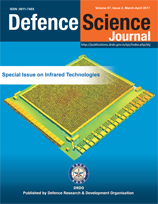Long Wave Infrared Type II Superlattice Focal Plane Array Detector
DOI:
https://doi.org/10.14429/dsj.67.11182Keywords:
Long Wave Infrared, LWIR, Superlattice, Type II superlattices, Focal plane arrayAbstract
The XBn/XBp family of barrier detectors enables diffusion limited dark currents comparable with HgxCd1-xTe Rule-07 and high quantum efficiencies. SCD’s XBp type II superlattice (T2SL) detector contains InAs/GaSb and InAs/AlSb T2SLs, and was designed for the long wave infrared (LWIR) atmospheric window using k · p based modeling of the energy bands and photo-response. Wafers are grown by molecular beam epitaxy and are fabricated into focal plane array (FPA) detectors using standard FPA processes, including wet and dry etching, indium bump hybridisation, under-fill, and back-side polishing. The 640 × 512 pixel, 15 μm pitch, detector goes by the name of ‘Pelican-D LW’ and exhibits a quantum efficiency of ~ 50 per cent with background limited performance at an operating temperature of 77 K. It has a cut-off wave length of ~ 9.5 μm, with a pixel operability of above 99 per cent. The detector gives a very stable image with a residual non uniformity of below 0.04 per cent over its useful dynamic range. A new digital read-out integrated circuit has been designed so that the complete detector closely follows the configuration of SCD’s MWIR Pelican-D detector.Downloads
Published
2017-03-14
How to Cite
Klipstein, P., Avnon, E., Benny, Y., Fraenkel, A., Glozman, A., Hojman, E., Ilan, E., Kahanov, E., Klin, O., Krasovitski, L., Langof, L., Lukomsky, I., Nitzani, M., Shkedy, L., Shtrichman, I., Snapi, N., Talmor, R., Tuito, A., Vaserman, S., & Weiss, E. (2017). Long Wave Infrared Type II Superlattice Focal Plane Array Detector. Defence Science Journal, 67(2), 135–140. https://doi.org/10.14429/dsj.67.11182
Issue
Section
Special Issue Papers
License
 Where otherwise noted, the Articles on this site are licensed under Creative Commons License: CC Attribution-Noncommercial-No Derivative Works 2.5 India
Where otherwise noted, the Articles on this site are licensed under Creative Commons License: CC Attribution-Noncommercial-No Derivative Works 2.5 India


